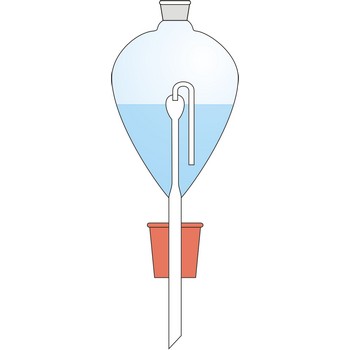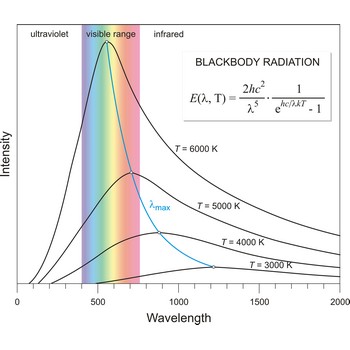Contat-Gockel’s valve → Contat-Gockelov ventil
Contat-Göckel’s valve is used for maintenance of inert atmosphere in a flask. The valve is filled with a saturated solution of sodium bicarbonate (NaHCO3) so that the end of the tube is covered. Solution inside the valve keeps the flask contents away from the oxygen influence from air. If low pressure is created inside the flask (when the flask is cooled), the solution will penetrate inside it from funnel and in a reaction with acid CO2 is generated which fills up the flask.
Solution from the funnel will keep penetrating until CO2 pressure in the flask is equalised with the outer pressure.
gold → zlato
Gold has been known since ancient times. The origin of the name comes from the Latin word aurum meaning gold. It is soft, malleable, bright yellow metal. Unaffected by air, water, alkalis and most acids. Gold is found in veins in the crust, with copper ore and native. Used in electronics, jewellery and coins. It is a good reflector of infrared radiation, so a thin film of gold is applied to the glass of skyscrapers to reduce internal heating from sunlight.
Goldschmidt process → Goldschmidtov postupak
Goldschmidt process (thermite process) is a method of extracting metals by reducing the oxide with aluminium powder. Practically all the metallic oxides are reducible by this method, the chief exception being the oxide of magnesium. The thermite process was developed by the German chemist Hans Goldschmidt (1861-1923) in 1893.
Goldschmidt was originally interested in producing very pure metals, but he soon realized the value in welding, a process known as Thermit welding.
Acheson process → Achesonov proces
Acheson process is an industrial process to synthesize graphite and silicon carbide (carborundum), named after its inventor the American chemist Edward Goodrich Acheson (1856-1931). In this process, a solid-state reaction between pure silica sand (SiO2) and petroleum coke (C) at very high temperature (more than 2500 °C) leads to the formation of silicon carbide under the general reaction:
While studying the effects of high temperature on carborundum, Acheson had found that silicon vaporizes at about 4150 °C, leaving behind graphitic carbon.
alpaca → alpaka
Alpaca (alpaka) or Nickel Silver is the generic name for any of a range of non-precious bright silvery-grey metal alloys, composed of copper, nickel and zinc. Despite its name it contains no real silver. It is also commonly called German Silver.
There are many different formulations of alloys which fall within the general term of Nickel Silver. All contain copper, nickel and zinc, while some formulations may additionally include antimony, tin, lead or cadmium. A representative formulation is 65 % copper, 18 % nickel, 17 % zinc. Nickel Silver is widely used for the commercial production of industrial components, housewares, flatware and cutlery, and as the metal substrate for silver-plated goods.
aqua regia → zlatotopka
Aqua regia is a mixture of one volume part of nitric acid (HNO3) and three volume parts of hydrochloric acid (HCl). Dissolving of gold in aqua regia is described by the following equation:
blackbody radiation → zračenje crnog tijela
Blackbody radiation is the radiation emitted by a perfect blackbody, i.e., a body which absorbs all radiation incident on it and reflects none. The primary law governing blackbody radiation is the Planck Radiation Law, which governs the intensity of radiation emitted by unit surface area into a fixed direction (solid angle) from the blackbody as a function of wavelength for a fixed temperature. The Planck Law can be expressed through the following equation
where λ is the wavelength, h is Planck’s constant, c is the speed of light, k is the Boltzmann constant, and T is the temperature.
bohrium → bohrij
Bohrium was discovered by Peter Armbruster, Gottfried Münzenber and their co-workers at the Heavy Ion Research Laboratory (Gesellschaft für Schwerionenforschung, GSI) in Darmstadt, Germany in 1981. Named in honour of Niels Bohr, the Danish physicist. It is synthetic radioactive metal. Bohrium was produced by bombarding bismuth-204 with chromium-54.
Citing this page:
Generalic, Eni. "Dlhwc-public@dol.gov." Croatian-English Chemistry Dictionary & Glossary. 29 June 2022. KTF-Split. {Date of access}. <https://glossary.periodni.com>.
Glossary
Periodic Table


